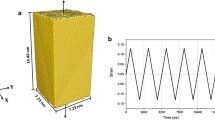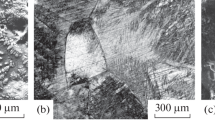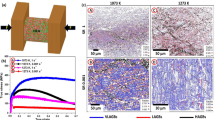Abstract
Temperature, strain rate, and defects are important considerations in determining the mechanical properties of materials. The mechanical properties of nanocrystalline copper-tantalum (Cu-Ta) alloy are investigated using classical molecular dynamics simulation approach in which embedded atom method of potential with periodic boundary conditions in all directions has been adopted. Numerical simulation has been performed to predict the mechanical properties of nanocrystalline copper-tantalum alloy. The virtual tensile test has been conducted at a fixed strain rate and increasing temperature where the discreet change in temperature from 50 to 1600 K has been used as a controlling parameter. The strain rate is fixed in the direction of the principal crystallographic planes and has not been affected by the change in temperature. The mechanical properties of the Cu-Ta nanocrystalline alloy such as yield strength, ultimate strength, and Young’s modulus are observed. Further, simulations are carried out to analyze the vacancy formation energy with vacancy concentration and potential energy response at discrete temperatures. Nanocrystalline Cu-Ta alloy is observed to be more susceptible to failure at high temperatures. Particularly at 300 K, the strength of nanocrystalline Cu-Ta is 6 GPa which decreases to 4 GPa at 1200 K.







Similar content being viewed by others
Data availability
The datasets generated during and/or analyzed during the current study are available from the corresponding author on reasonable request.
Code availability
The custom code generated for the current study is available from the corresponding author on reasonable request.
References
Suryanarayana C, Koch C (2000) Nanocrystalline materials – current research and future directions. Hyperfine Interact 130:5
Birringer R (1989) Nanocrystalline materials. Mater Sci Eng A 117(33–43):09215093
Tian L (2017) A short review on mechanical behavior of nanocrystalline materials. Int J Metall Met Phys 2:008
Meyers MA, Mishra A, Benson DJ (2006) Mechanical properties of nanocrystalline materials. Prog Mater Sci 51(4):427–556
Pandey AK, Siddiqui SA, Dwivedi A, Raj K, Misra N (2011) Density functional theory study on the molecular structure of loganin. J Appl Spectrosc 25:361849
Metropolis N, Ulam S (1949) The Monte Carlo method. J Am Stat Assoc 44(247):335–341
Iftimie R, Minary P, Mark E, Tuckerman. (2005) Ab initio molecular dynamics: concepts, recent developments, and future trends. Proc Natl Acad Sci USA 102(19):6654–6659
Foulkes WMC, Mitas L, Needs RJ, Rajagopal G (2001) Quantum Monte Carlo simulations of solids. Rev Mod Phys 73(1):33–83
McQuarrie DA (1976) Statistical mechanics. Harper & Row, New York
Rice BM, and Sewell TD. (2008) Equilibrium molecular dynamics simulations. In: Peiris, S.M., Piermarini, G.J. (eds) Static compression of energetic materials. Shock wave and high pressure phenomena. Springer, Berlin, Heidelberg.
Lu L, Li SX, Lu K (2001) An abnormal strain rate effect on tensile behavior in nanocrystalline copper. Scr Mater 45(10):1163–1169
Yang X, Zhai P, Li L, Zhang Q (2012) Molecular dynamics simulation on mechanical properties of crystalline CoSb3 with vacancy defect. Physica B Condens Matter 407(12):2234–2238
Dewapriya MAN, Rajapakse RKND (2014) Molecular dynamics simulations and continuum modeling of temperature and strain rate dependent fracture strength of graphene with vacancy defects. J Appl Mech 81(8):081010
Hahn EN, Germann TC, Ravelo R, Hammerberg JE, Meyers MA (2017) On the ultimate tensile strength of tantalum. Acta Mater 126:313–328
Ruan Z, Wu W, Li N (2018) Effects of strain rate, temperature and grain size on the mechanical properties and microstructure evolutions of polycrystalline nickel nanowires: a molecular dynamics simulation. Wuhan Univ J Nat Sci 23:251–258
Ruicheng F, Hui C, Haiyan L, Zhiyuan R, Changfeng Y (2018) Effects of vacancy concentration and temperature on mechanical properties of single-crystal γ-TiAl based on molecular dynamics simulation. High Temp Mater Process 37(2):113–120
Srinivasan S, Sharma S, Turnage S, Hornbuckle BC, Kale C, Darling KA, Solanki K (2021) Role of tantalum concentration, processing temperature, and strain-rate on the mechanical behavior of copper-tantalum alloys. Acta Mater 208:116706
Cotterill RMJ. and Pedersen LB. (1972) Temperature dependence of the vacancy formation energy in krypton by molecular dynamic simulation. Department of Structural Properties of Materials, Plenum Press, 2800 Lyngby - Denmark.
Plimpton S (1995) Fast parallel algorithms for short-range molecular dynamics. J Comput Phys 117(1):1–19
Daw MS, Foiles SM, Baskes MI (1993) The embedded-atom method: a review of theory and applications. Mater Sci Eng R Rep 9(7):251–310
Diwan BD (2013) Size effect on the cohesive energy of palladium nanoparticle. J Comput Theor Nanosci 10(11):2779–2781
Bringa EM, Caro A, Wang Y, Victoria M, Mcnaney JM, Remington BA, Smith RF, Torralva BR, Swygenhoven HV (2005) Ultrahigh strength in nano-crystalline materials under shock loading. Science 309(5742):1838–1841
Rudd RE, Germann TC, Remington BA, Wark JS (2010) Metal deformation and phase transitions at extremely high strain rates. MRS Bull 35:999–1006
Holian BL, Lomdahl PS (1998) Plasticity induced by shock waves in nonequilibrium molecular-dynamics simulations. Science 280:2085–2088
Subramanian PR, Laughlin DE (1989) The Cu-Ta (copper-tantalum) system. Bull alloy phase diagr 10(6):652–655
Zhao Y, Lu G (2009) First-principles simulations of copper diffusion in tantalum and tantalum nitride. Phys Rev B Condens Matter Mater Phys 79(21):1–9
Monticelli L, Tieleman DP (2013) Force fields for classical molecular dynamics. Methods Mol Biol 924:197–213
Gonzalez MA (2011) Force fields and molecular dynamics simulations. Neutrons et Simulations 12:169–200
Zhou XW, Johnson RA, Wadley HNG (2004) Misfit-energy-increasing dislocations in vapor-deposited CoFe/NiFe multilayers. Phys Rev B 69:144113
Hirel P (2015) Atomsk: a tool for manipulating and converting atomic data files. Comput Phys Commun 197:212–219
Kalibaeva G, Ferrario M, Ciccotti G (2003) Constant pressure-constant temperature molecular dynamics: a correct constrained NPT ensemble using the molecular virial. Mol Phys 101(6):765–778
Nazareth J (2009) Conjugate gradient method. Wiley Interdisciplinary Reviews: Comput Stat 1(3):348–353
Belak J (1998) On the nucleation and growth of voids at high strain-rates. J Comp-Aid Mater Des 5(2–3):193–206
Tang Y, Bringa EM, Meyers MA (2012) Ductile tensile failure in metals through initiation and growth of nanosized voids. Acta Mate 60:4856–4865
Sadeghzadeh S (2018) Effects of vacancies and divacancies on the failure of C3N nanosheets. Diam Relat Mater 89:257–265
Stukowski A (2010) Visualization and analysis of atomistic simulation data with OVITO-the open visualization tool. Model Simul Mat Sci Eng 18:015012
Chen P, Zhang Z, Liu C, An T, Yu H, Qin F (2019) Temperature and grain size dependences of mechanical properties of nanocrystalline copper by molecular dynamics simulation. Model Simul Mat Sci Eng 27:065012
Antoun T, Seaman L, Kanel D, Razorenov G (2003) Spall fracture. Springer, New York
Lubarda V, Schneider M, Kalantar D, Remington B, Meyers M (2004) Void growth by dislocation emission. Acta Mater 52:1397–1408
Meyers M, Aimone C (1983) Dynamic fracture (spalling) of metals. (1983) Prog Mater Sci 28:1–96
Li Z, Gao Y, Zhan S, Fang H, Zhang Z (2020) Molecular dynamics study on temperature and strain rate dependences of mechanical properties of single crystal Al under uniaxial loading. AIP Adv 10:075321
Turnage SA, Rajagopalan M, Darling KA, Garg P, Kale C, Bazehhour B (2018) Anomalous mechanical behavior of nanocrystalline binary alloys under extreme conditions. Nat Commun 9:2699
Wang W, Ma Y, Yang M, Jiang P, Yuan F, Wu X (2018) Strain rate effect on tensile behavior for a high specific strength steel: from quasi-static to intermediate strain rates. Metals 8(1):11
Wang W, Yi C, Fan K (2013) Molecular dynamics study on temperature and strain rate dependences of mechanical tensile properties of ultrathin nickel nanowires. Trans Nonferrous Met Soc 23:3353–3361
Yu R, Zhai P, Li G, Liu L (2012) Molecular dynamics simulation of the mechanical properties of single-crystal bulk Mg2Si. J Electron Mater 41:1465–1469
Author information
Authors and Affiliations
Contributions
All authors contributed to the study conception and design of the study. Mahesh Kumar Gupta: methodology, software, investigation, writing—original draft. Vinay Panwar: conceptualization, writing—review and editing, supervision, project administration. Rajendra Prasad Mahapatra: validation, formal analysis, supervision. All authors read and approved the final manuscript.
Corresponding author
Ethics declarations
Competing interests
The authors declare no competing interests.
Additional information
Publisher's note
Springer Nature remains neutral with regard to jurisdictional claims in published maps and institutional affiliations.
Rights and permissions
About this article
Cite this article
Gupta, M.K., Panwar, V. & Mahapatra, R.P. Computational analysis of mechanical behavior and potential energy of thermoresponsive copper-tantalum nanoalloy. J Mol Model 28, 187 (2022). https://doi.org/10.1007/s00894-022-05183-y
Received:
Accepted:
Published:
DOI: https://doi.org/10.1007/s00894-022-05183-y




